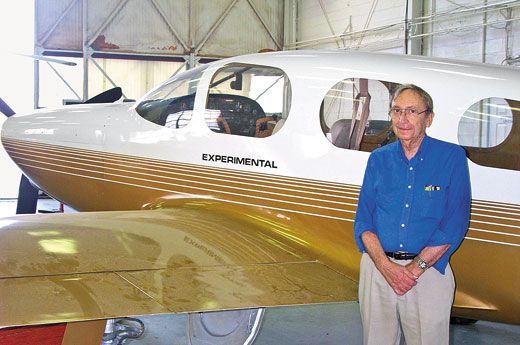Making a Smoother (and Speedier) Airplane
Within months of its first flight, August Bellanca’s Skyrocket II set five world speed records.
/https://tf-cmsv2-smithsonianmag-media.s3.amazonaws.com/filer/Moments-Milestones-Skyrocket-FLASH.jpg)
In March 2010 in Annapolis, Maryland, August Bellanca, son of aviation pioneer Giuseppe Bellanca, died during a course of chemotherapy. He had worked at Giuseppe’s factory in Delaware during his teens, following his famous father’s path into aeronautics. At the time of his death, he was working as an engineer for the U.S. Navy at Patuxent River’s Conceptual Design Center.
During the latter part of his life, he was the president of a company called AviaBellanca. It was in that role that he began to pursue a high-performance, single-engine airplane design that would employ composite materials to provide exceptional surface smoothness. For the wing’s airfoil, Bellanca chose the NACA 632-215, from the National Advisory Committee for Aeronautics’ controversial 6-series, a family of shapes from the 1940s that the committee anticipated would provide natural laminar flow—the perfect non-turbulent passage of air over the forward portion of a wing’s surface. If we could see laminar flow, it would look like very thin sheets of air sliding smoothly over each other at increasing speeds, starting from the boundary layer, which has zero velocity.
Some of the controversy surrounding the 6-series arose when the airfoils were employed on military aircraft, notably the North American P-51 Mustang. In testing, the airfoil family had disappointed. Metal aircraft were assembled with rivets, and even flush rivets, while an improvement, were enough to make the airflow over much of the wing surface turbulent. By the 1970s, though, a diverse group of innovative composite airplanes with almost perfectly smooth surfaces, including the Windecker Eagle, Burt Rutan’s Vari-Eze, and August Bellanca’s Skyrocket II, had caught the attention of NASA. The agency set out to explore whether these new materials might provide advantages, and perhaps redeem the whole notion of natural laminar flow, using the 6-series airfoil.
Payne Engineering, a company founded in Princeton in 1959 by a brilliant polymath named Henry E. Payne III, took the project under its wing and built Bellanca’s Skyrocket II—named in tribute to one of his father’s early designs. It was completed in 1975.
The scientist Bruce Holmes is probably best known today for his work on NASA’s Small Aircraft Transportation Program, but in 1984, with Clifford J. Obara and Long P. Yip, he authored a NASA technical paper summarizing the results: “Natural Laminar Flow Experiments on Modern Aircraft Surfaces.” These experiments, conducted at the agency’s Langley Research Center in Virginia, used a novel technique to ascertain whether natural laminar flow was achieved. The researchers sprayed a thin layer of a light-colored chemical in a broad stripe down the span of the Skyrocket II’s dark wing at the mid-chord point. The scientists chose chemicals, such as naphthalene, diphenyl, acenaphthene, and fluorine, that would sublimate (go from solid state to a vapor) where turbulence was present, so after the aircraft had flown, if the light stripe was gone, that meant turbulence had been produced.
In 2003, former NASA researcher Joseph Chambers wrote of the series of tests, “The results of the Skyrocket flight test vividly demonstrated the presence of laminar flow on the wing to the point of maximum wing thickness. This research activity represented a significant milestone because aerodynamic wing design for future low- and medium-speed general aviation composite aircraft could now consider laminar flow as an achievable goal.”
We’ll never know how great the Skyrocket II would have been. In a 1983 interview with Flying magazine, Bellanca estimated it would take between $20 million and $25 million to get the airplane certified. Only one Skyrocket II was ever built, but its world speed records over distances of 500 kilometers (a little over 300 miles) and 1,000 km are still on the books at the National Aeronautic Association.
